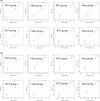Comparison of breast-conserving surgery without radiotherapy and mastectomy in the treatment of elderly patients with early breast cancer: A PSM and SEER database study
- PMID: 37269188
- PMCID: PMC10417188
- DOI: 10.1002/cam4.6210
Comparison of breast-conserving surgery without radiotherapy and mastectomy in the treatment of elderly patients with early breast cancer: A PSM and SEER database study
Abstract
Background: At present, there is no research on which surgical method can lead to a better prognosis in elderly patients with early breast cancer. The purpose of this study was to establish a nomogram to predict the survival outcome of elderly patients with early breast cancer and to compare the prognosis of the breast-conserving surgery (BCS) group who did not receive postoperative radiotherapy and the mastectomy group through risk stratification.
Methods: This study included patients with early breast cancer aged ≥70 years from the Surveillance, Epidemiology, and End Results database (n = 20,520). The group was randomly divided into a development cohort (n = 14,363) and a validation cohort (n = 6157) according to a ratio of 7:3. Risk factors affecting overall survival (OS) and breast-cancer-specific survival (BCSS) were analyzed using univariate and multivariate Cox regression. Present results were obtained by constructing nomograms and risk stratifications. Nomograms were evaluated by the concordance index and calibration curve. Kaplan-Meier curves were established based on BCSS and analyzed using the log-rank test.
Results: Multivariate Cox regression results showed that age, race, pathological grade, T and N stages, and progesterone receptor (PR) status were independent risk factors for OS and BCSS in the BCS group and mastectomy group. Subsequently, they were incorporated into nomograms to predict 3- and 5-year OS and BCSS in patients after BCS and mastectomy. The concordance index was between 0.704 and 0.832, and the nomograms also showed good calibration. The results of risk stratification showed that there was no survival difference between the BCS group and the mastectomy group in the low-risk and high-risk groups. In the middle-risk group, BCS improved the BCSS of patients to a certain extent.
Conclusion: This study constructed a well-performing nomogram and risk stratification model to assess the survival benefit of BCS without postoperative radiotherapy in elderly patients with early breast cancer. The results of the study can help clinicians analyze the prognosis of patients and the benefits of surgical methods individually.
Keywords: Epidemiology, and End Results (SEER); Surveillance; breast cancer; breast-conserving surgery (BCS); elderly; mastectomy; nomogram; propensity score matching (PSM).
© 2023 The Authors. Cancer Medicine published by John Wiley & Sons Ltd.
Conflict of interest statement
The authors declare that there is no conflict of interest regarding the publication of this article.
Figures





Similar articles
-
Survival Comparisons between Breast Conservation Surgery and Mastectomy Followed by Postoperative Radiotherapy in Stage I-III Breast Cancer Patients: Analysis of the Surveillance, Epidemiology, and End Results (Seer) Program Database.Curr Oncol. 2022 Aug 15;29(8):5731-5747. doi: 10.3390/curroncol29080452. Curr Oncol. 2022. PMID: 36005190 Free PMC article.
-
Can Radiotherapy After Breast-Conserving Surgery be Omitted in Elderly Patients with Early-Stage, Hormone-Receptor Negative Breast Cancer? A Population-Based Study and Proposed Nomogram.Adv Ther. 2022 Oct;39(10):4707-4722. doi: 10.1007/s12325-022-02279-y. Epub 2022 Aug 11. Adv Ther. 2022. PMID: 35953665
-
Establishment and validation survival prediction models for T1 locally advanced breast cancer after breast conservation surgery versus mastectomy.Sci Rep. 2025 Apr 9;15(1):12189. doi: 10.1038/s41598-025-91205-7. Sci Rep. 2025. PMID: 40204827 Free PMC article.
-
Prognostic nomograms for young breast cancer: A retrospective study based on the SEER and METABRIC databases.Cancer Innov. 2024 Oct 25;3(6):e152. doi: 10.1002/cai2.152. eCollection 2024 Dec. Cancer Innov. 2024. PMID: 39464427 Free PMC article. Review.
-
Endoscopy-assisted breast conservation surgery (E-BCS) vs conventional breast conservation surgery (C-BCS) technique for the management of early breast cancer: A systematic review and meta-analysis.Breast Dis. 2023;42(1):383-393. doi: 10.3233/BD-230023. Breast Dis. 2023. PMID: 38108340
Cited by
-
Effect of surgery on breast cancer-specific mortality in older adults with endocrine receptor-positive and HER2-negative breast cancer.J Rural Med. 2025 Jul;20(3):225-232. doi: 10.2185/jrm.2025-009. Epub 2025 Jul 1. J Rural Med. 2025. PMID: 40636251 Free PMC article.
-
Race as a prognostic factor of breast mucinous carcinoma.J Cancer Res Clin Oncol. 2024 Dec 27;151(1):25. doi: 10.1007/s00432-024-06035-3. J Cancer Res Clin Oncol. 2024. PMID: 39729234 Free PMC article.
-
The prognostic differences between breast-conserving surgery and mastectomy in patients with invasive ductal carcinoma who achieved complete response following neoadjuvant chemotherapy: a propensity score matched analysis based on the SEER database.World J Surg Oncol. 2025 Jul 8;23(1):269. doi: 10.1186/s12957-025-03932-w. World J Surg Oncol. 2025. PMID: 40629357 Free PMC article.
-
Changes to the US Preventive Services Task Force Screening Guidelines and Incidence of Breast Cancer.JAMA Netw Open. 2024 Dec 2;7(12):e2452688. doi: 10.1001/jamanetworkopen.2024.52688. JAMA Netw Open. 2024. PMID: 39729313 Free PMC article.
References
-
- Sung H, Ferlay J, Siegel RL, et al. Global cancer statistics 2020: GLOBOCAN estimates of incidence and mortality worldwide for 36 cancers in 185 countries. CA Cancer J Clin. 2021;71(3):209‐249. - PubMed
-
- Tran P, Fentiman IS. Better treatment for breast cancer in older patients. Expert Rev Anticancer Ther. 2009;9(8):1081‐1090. - PubMed
-
- Biganzoli L, Wildiers H, Oakman C, et al. Management of elderly patients with breast cancer: updated recommendations of the International Society of Geriatric Oncology (SIOG) and European Society of Breast Cancer Specialists (EUSOMA). Lancet Oncol. 2012;13(4):e148‐e160. - PubMed
MeSH terms
LinkOut - more resources
Full Text Sources
Medical
Research Materials
Miscellaneous

